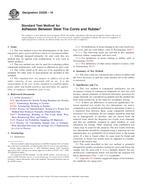Potřebujeme váš souhlas k využití jednotlivých dat, aby se vám mimo jiné mohly ukazovat informace týkající se vašich zájmů. Souhlas udělíte kliknutím na tlačítko „OK“.
ASTM D2229-10
Standard Test Method for Adhesion Between Steel Tire Cords and Rubber
Automaticky přeložený název:
Standardní zkušební metoda pro přilnavosti mezi Ocelové do pneumatik a gumy
NORMA vydána dne 1.1.2010
Informace o normě:
Označení normy: ASTM D2229-10
Poznámka: NEPLATNÁ
Datum vydání normy: 1.1.2010
Kód zboží: NS-19685
Počet stran: 7
Přibližná hmotnost: 21 g (0.05 liber)
Země: Americká technická norma
Kategorie: Technické normy ASTM
Anotace textu normy ASTM D2229-10 :
Keywords:
adhesion, rubber, steel, tire cord, Acceptance criteria/testing--textile fabrics/fibers, Rubber adhesion, Steel cords, Tire cords and tire cord fabrics, ICS Number Code 83.060 (Rubber)
Doplňující informace
| Significance and Use | ||||||||||||||
|
This test method is considered satisfactory for the acceptance testing of commercial shipments of steel tire cord because current estimates of between-laboratory precision for single materials are considered acceptable and the method has been used extensively in the trade for acceptance testing. If there are differences or practical significances between reported test results for two laboratories (or more), comparative tests should be performed to determine if there is a statistical bias between them, using competent statistical assistance. As a minimum, the test samples should be used that are as homogenous as possible, that are drawn from the material from which the disparate test results were obtained, and that are randomly assigned in equal numbers to each laboratory for testing. Other materials with established test values may be used for this purpose. The test results from the two laboratories should be compared using a statistical test for unpaired data, at a probability level chosen prior to the testing series. If a bias is found, either its cause must be found and corrected, or future test results must be adjusted in consideration of the known bias. The mold described in this test method is primarily designed for quality acceptance testing for steel cord where the sample size for each cord is 4 or a multiple thereof, but any mold/cavity combination which will provide the required test block dimensions (Figs. 1 and 2) is acceptable. Appendix X1 contains suggested ranges of environmental conditions for aging tests. The property measured by this test method indicates whether the adhesion of the steel cord to the rubber is greater than the cohesion of the rubber, that is, complete rubber coverage of the steel cord, or less than the cohesion of the rubber, that is, lack of rubber coverage. |
||||||||||||||
| 1. Scope | ||||||||||||||
|
1.1 This test method covers the determination of the force required to pull a steel cord from a block of vulcanized rubber. 1.2 Although designed primarily for steel cord, this test method may be applied with modifications to wire used in rubber products. 1.3 This test method can also be used for evaluating rubber compound performance with respect to adhesion to steel cord. 1.4 The values stated in SI units are to be regarded as the standard. No other units of measurement are included in this standard. 1.5 This standard does not purport to address all of the safety concerns, if any, associated with its use. It is the responsibility of the user of this standard to establish appropriate safety and health practices and determine the applicability of regulatory limitations prior to use. |
||||||||||||||
| 2. Referenced Documents | ||||||||||||||
|
Doporučujeme:
EviZak - všechny zákony včetně jejich evidence na jednom místě
Poskytování aktuálních informací o legislativních předpisech vyhlášených ve Sbírce zákonů od roku 1945.
Aktualizace 2x v měsíci !
Chcete vědět více informací? Podívejte se na tuto stránku.




 Cookies
Cookies
